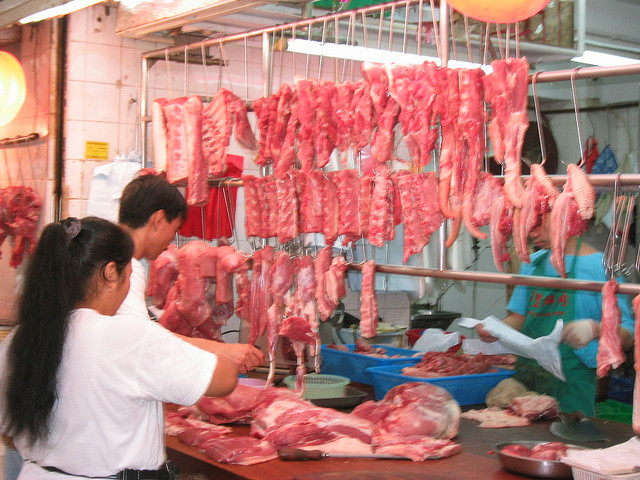Just How to Pick the Perfect Cut of Meat From a Trusted Meat Market
Choosing the ideal cut of meat from a relied on meat market calls for a thoughtful approach that balances top quality, culinary purpose, and spending plan. Understanding the various kinds of meat and their particular cuts is important, as is engaging with your butcher to gain insights right into sourcing and preparation. Observing features such as shade, appearance, and marbling can additionally lead your decision. As you take into consideration these factors, it becomes clear that the nuances of your selection can considerably affect the end result of your meal, triggering a deeper exploration of the standards that genuinely matter.
Recognizing Meat Cuts


For circumstances, the tenderloin is valued for its buttery appearance and minimal connective cells, making it excellent for fast food preparation methods such as barbecuing or pan-searing. In contrast, tougher cuts like the brisket or shank benefit from slow-moving cooking strategies to damage down collagen, yielding abundant and flavorful results.
Furthermore, the fat material of a cut plays a critical role in taste account and wetness retention throughout cooking. Cuts with higher fat web content, such as ribeye, provide an even more durable flavor, while leaner alternatives, like sirloin, may call for mindful preparation to prevent dry skin (bagley meat market edwardsville il). Recognizing these nuances permits educated choices that boost cooking creations, ensuring that each meal showcases the very best qualities of the picked meat
Aspects to Consider
When choosing the ideal cut of meat, several crucial variables enter play that can considerably influence the final meal. Consider the type of meat you desire-- beef, pork, lamb, or chicken-- as each deals distinct flavors and textures. The specific cut within that category is just as crucial; for circumstances, ribeye provides rich marbling, while tenderloin provides a lean, buttery appearance.
An additional aspect is the food preparation technique you plan to use. Cuts ideal for grilling, such as T-bones or sirloins, vary from those far better matched for slow-moving cooking, like chuck roasts or shanks. In addition, freshness is paramount; constantly choose meat with a dynamic shade and company texture, signaling high quality and correct handling.
Moreover, take into consideration the source of the meat. A trusted meat market often supplies locally sourced, hormone-free, and grass-fed options, which can boost flavor and nutritional value. Last but not least, your budget will certainly lead your option. Costs cuts might supply extraordinary taste, but there are likewise cost-efficient choices that, when prepared appropriately, can generate scrumptious results. Balancing these aspects will help you choose the excellent cut for your culinary demands.
Questions to Ask Your Butcher
A butcher's know-how can be invaluable when choosing the optimal cut of meat for your cooking endeavors (bagley meat market edwardsville il). To maximize this source, take into consideration asking comprehensive concerns that can guide your choices. Start by inquiring concerning the source of the meat. Recognizing where it comes from can provide insights into its high quality and taste profile.
Following, ask regarding the different cuts offered for the kind of meat you choose. A well-informed butcher will explain the subtleties of each cut, helping you choose one that matches your cooking approach and desired end result. Don't be reluctant to ask concerning the finest cooking strategies for a details cut; butchers often have suggestions that can enhance your meal.
It's likewise prudent to ask regarding the meat's freshness. A great butcher will be anxious to share their experience and recommend cuts that will certainly delight your taste. Involving your butcher with these article inquiries can significantly enhance your meat selection experience.
Identifying Top Quality Meat

Structure is an additional important element; high quality meat should feel solid and a little springy to the touch. Avoid any kind of cuts that feel slimy or excessively dry, as these can indicate putridity or incorrect storage. In addition, smell plays a vital role; fresh meat ought to have a clean, neutral fragrance, while any type of repulsive or sour smells are red flags.
Finally, think about the resource. Investing in from a trusted meat market, where the meat's beginning is known, can guarantee higher quality standards. By concentrating on these indications-- shade, marbling, structure, smell, and resource-- you can confidently select cuts that will certainly boost your food preparation and dining experience.
Cooking Methods for each and every Cut
Picking the ideal cooking method is extremely important for making the most of the taste and inflammation of each cut of meat. Different cuts have special attributes that dictate one of the most appropriate cooking strategies.
For tender cuts, such as filet mignon or ribeye, completely dry warm methods like barbecuing, broiling, or pan-searing are excellent. Alternatively, harder cuts, such as chuck or brisket, benefit from damp warm methods, including braising or slow cooking.
Pork chops and hen breasts are versatile and can be cooked using both dry and wet methods. While grilling or roasting can generate delicious results, poaching or you can find out more sautéing can redirected here keep dampness and inflammation. For lamb, methods like roasting or braising are recommended, as they enhance the meat's robust flavor.

Conclusion
Finally, picking the optimal cut of meat from a trusted meat market demands a thorough understanding of meat cuts and consideration of different variables, including source, quality, and cooking methods. Involving with the butcher through targeted queries can produce beneficial understandings and suggestions customized to particular culinary demands. Prioritizing both top quality and budget will certainly improve the general gastronomic experience, making certain that the chosen cut satisfies expectations in both taste and preparation.